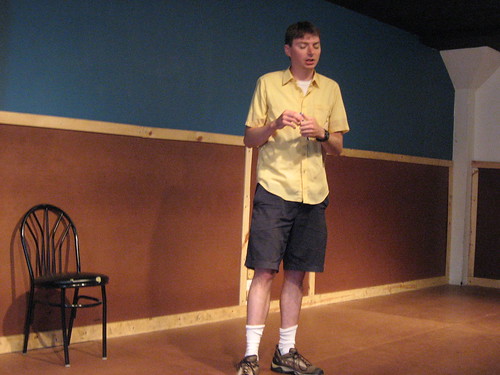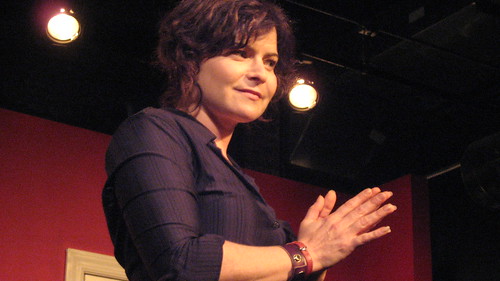Firstlyness, I need to standardize how I refer to the days of this program. It's five weeks, five levels and four days a week. From now on, I'm gonna just refer to the overall day count, so there's no confusion about "which day four?" That being said, my last post was about how crappy I felt on Day 7, but as the teaser noted, day 8 rocked.
At the beginning of class we talked about the amazing TJ and Dave show many of us saw the night before. I need to set this up a bit.
TJ and Dave are two master, veteran improvisors who have been doing their two-man show every week for about six years. The consistently sell out the show and collect rave reviews. There are so few shows I've seen in my life that impressed me to the point of simultaneously thinking, "I should abandon this performance business" and "that's what art can be." One such show is
The Whitest Kids U Know, who have honored me by having me open their show with standup. Another is
Black Folks Guide to Black Folks by Hanifah Walidah.
Seeing TJ and Dave (along with buying some comfortable shoes and getting a good night's sleep) is what pulled me out of my day 7 funk and fatigue. These two dudes walk on stage, take an audience suggestion and improvise a show for 45 minutes! This week, they began as motorcade secret service agents, and it was beautiful. If they ever hit the road or put out a DVD, I will definitely let yall know. So in Day 8 of class we started the day by talking about their show.
- They moved slowly. They didn't speak for 30-45 seconds at the top of the show, then one of them said, "So, first time workin the motorcade?"
- They transitioned into and out of characters very smoothly, using every tool they had. Facial expressions, speaking style and posture all changed as they morphed from character to character. They didn't rapidly juggle characters (the way Practice Scaring a Bear did amazingly well), but they made beautifully deliberate choices. They defined characters so well, that when TJ began enacting the Senator they'd created, Dave was later able to play that same senator while TJ was motorcade guy. Even though these two men don't look alike, they both looked like the same senator somehow.
- They didn't go for the easy nor obvious laugh. The laughter was a byproduct.
- They have huge balls, as Rachael said, because they didn't even solicit and audience suggestion!
Creating Massively Multiplayer Scenes
I just gotta say, Rachael loves to fuck with us. Apologies for the profanity. I use it rarely here, but it is truly the most appropriate word. The Level 2 curriculum was designed by Susan Messing (more on her in another post), who just loves to fuck with people. She'll use hella profanity, obscenity and other under-the-skin-getting techniques to push your knowledge.
Rachael broke us into two groups on stage, and she told us we had "five minutes to prepare a bit." What does that mean? NOTHING! We don't work that way? What's a "bit" anyway? And what does "prepare" mean. Each group huddled and threw out ideas. We considered writing a little sketch. We thought maybe her point was that improv is easier than writing a sketch together. We looked at her. She looked at us. She yelled the countdown, "TWO MINUTES!!" When it was our turn to present, we did an opening and some story theatre piece and closed it.
Lesson: you don't have time to mull over a thousand different ideas and "plots." Just YES-AND (that's the main improvisors credo. Say "yes" to whatever your teammate throws out there "and" add information) the first idea, and build from there. We could have better used that five minutes doing random warmups.
Next exercise: same thing. This time, some in our group taught the others a warmup called "Show Us How to Get Down," which is a dance number type thing. At the last second before we ran out of time, somebody said, our theme is "dance." But when we started, another teammate asked for a suggestion from the audience. We got something different, and YES-ANDed that joint.
Next exercise: Rachael mixed up our teams. We did it all again.
Lesson: you can do improv with anyone. It's nice to have team chemistry, but it's not necessary.
Out of this chaos, we then took to the stage four or five or seven at a time to create scenes with more than two people. Rachael gave us physical locations (teacher's lounge, jail, hospital waiting room), and we filled in the rest, defining the environment, using objects, establishing relationships with the other characters. These were the most fun scenes I've done, and each one was hilarious. I'm serious. We whipped out three scenes in six minutes with no planning, and they were all very funny! It's like magic.
To the Beat of the Rhythm of the Night
Our next stop was the
Busby Berkeley dance routine. These are the old school cabaret, old Vegas, feathere boa-style, synchronized moves that only exist in musicals or films/plays about the mid 20th century. We lined up according to height and created that beauty on the fly by creating patterns and paying attention to each other.
Lesson: rhythm. (which should give black folks an unfair improv advantage right? :))
A Positive Intervention
Our final and coolest exercise involved two people sitting on the stage in front of the rest of our class. We gave them a massive standing ovation, then Rachael would ask, "So tell me what you love about Jeff." We would talk about how Jeff is an amazing team player, makes surprising character choices, is generous, etc. Then she would ask, "Tell me what you'd like to see more of from Jeff." And we'd say, "maybe a bit less active" or "play someone higher status, in charge." Rachael then added more of her own feedback from watching us all week. We did this for both players, and Rachael then set them up in a scene together with assignments of character traits based on the group feedback.
This was a really powerful way to provide constructive criticism. It's one thing for the teacher to hand you a "report card." It's another (more effective) thing to hear the collective thoughts of your teammates on your strengths and weaknesses, however.
For me, the positives included:
- great energy
- "heart of gold." really, someone said this. I was so touched. Then I died, because while it's nice to have a heart of gold in theory, in practice, it's not so good at powering the circulatory system
- versatile player
- great with anything involving song
- great well-rounded performer
- beautiful smile
- very positive
And what they wanted to see more of:
- play someone serious. hard.
- use more accents
- play the straight man. don't provide the laughs. support the guy that does
In my scene, I was paired with Gabe, who was told to be bigger and outlandish. We were set in a warehouse where we moved boxes. Gabe talked all about partying and how hungover he was. I played it straight and mostly silence, adding occasionally, "I am here to work." or "This job provides for my family." The interestingness came when Gabe started talking about how sexy my daughter was. This comment finally got me to stop moving the boxes and look at Gabe for the first time. "Do not talk about my daughter." Gabe continued though. Me again: "This is the last time. Don't talk about my daughter that way again." Silence, silence, and Gabe throws out one more line about how he'd do X to her, and just as I was preparing to leap on him, the scene ended.
The one snafu in the scene was about 1/3rd of the way through, I took on a more pronounced African accent. I didn't think I had said enough for the audience to know I didn't have one before, but Rachael noticed and paused the scene. "Keep your shit!" she yelled. I had just been remembering the feedback to use more accents, but it was a good lesson. Once you make a character choice, you have to stick with it.
So that was day 8 in class.
That night, I saw a two-person show at
The Annoyance featuring the legendary
Susan Messing with legendary
Mick Napier. I saw it was good, said it was good, and it was good.
 New week. New level. New teacher. Introducing Pat O'Brien, a director at Second City and a member of the young "team to watch" at iO, The Reckoning.
First, I gotta say, it's been great to have teachers that actually do improv, regularly, and well. The Reckoning is that cool young team that everyone's talking about. They do two shows a week. One is a straight Harold format. The other is them experimenting with all kinds of form. I saw one show, referred to as a Bat, where they did the whole show in the dark. No physical movement was involved, just speaking and some sound effects from random crap they brought onstage. It reminded me of old radio shows my mom loved.
The purpose of week 4 is to really learn The Harold, that infamous, all-encompasing, truth-seeking, and very challenging structure pioneered by Del Close himself.
Harold Diagnostic
Pat began class by splitting us into two groups of seven and eight, respectively. Each group did a full Harold based on what we'd learned already, and he offered a boatload of feedback, criticisms and ideas. As it would become clearer over the course of the week, one of Pat's strengths is in showing us the possibilities for any given show or scene. He helped us think about the connections we didn't pick up on that could make a show much better. Given the amount of information one must keep track of in a Harold, he also shared a simple but infinitely valuable tip:
Keep it fun, and focus on one aspect of the Harold at a time.
For example, in one show you might decide that you're gonna focus on editing. In another, you focus on playing emotionally. Etc. etc.
His advice after watching our first two Harolds included:
New week. New level. New teacher. Introducing Pat O'Brien, a director at Second City and a member of the young "team to watch" at iO, The Reckoning.
First, I gotta say, it's been great to have teachers that actually do improv, regularly, and well. The Reckoning is that cool young team that everyone's talking about. They do two shows a week. One is a straight Harold format. The other is them experimenting with all kinds of form. I saw one show, referred to as a Bat, where they did the whole show in the dark. No physical movement was involved, just speaking and some sound effects from random crap they brought onstage. It reminded me of old radio shows my mom loved.
The purpose of week 4 is to really learn The Harold, that infamous, all-encompasing, truth-seeking, and very challenging structure pioneered by Del Close himself.
Harold Diagnostic
Pat began class by splitting us into two groups of seven and eight, respectively. Each group did a full Harold based on what we'd learned already, and he offered a boatload of feedback, criticisms and ideas. As it would become clearer over the course of the week, one of Pat's strengths is in showing us the possibilities for any given show or scene. He helped us think about the connections we didn't pick up on that could make a show much better. Given the amount of information one must keep track of in a Harold, he also shared a simple but infinitely valuable tip:
Keep it fun, and focus on one aspect of the Harold at a time.
For example, in one show you might decide that you're gonna focus on editing. In another, you focus on playing emotionally. Etc. etc.
His advice after watching our first two Harolds included:



